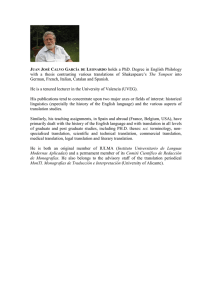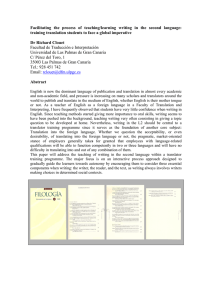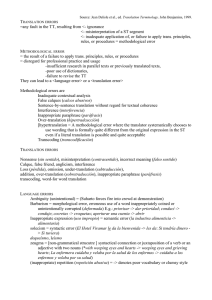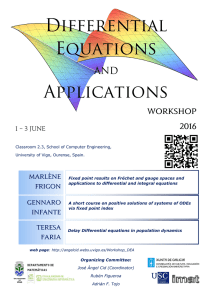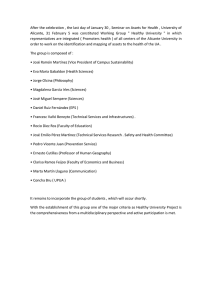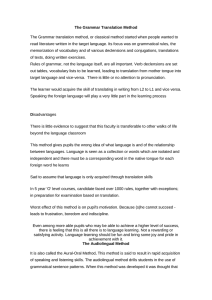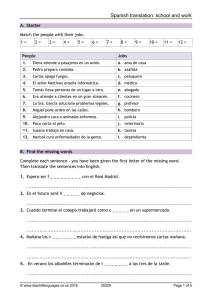Zig-Zag: The first on-line scientific IPTV program devoted to translation
Anuncio
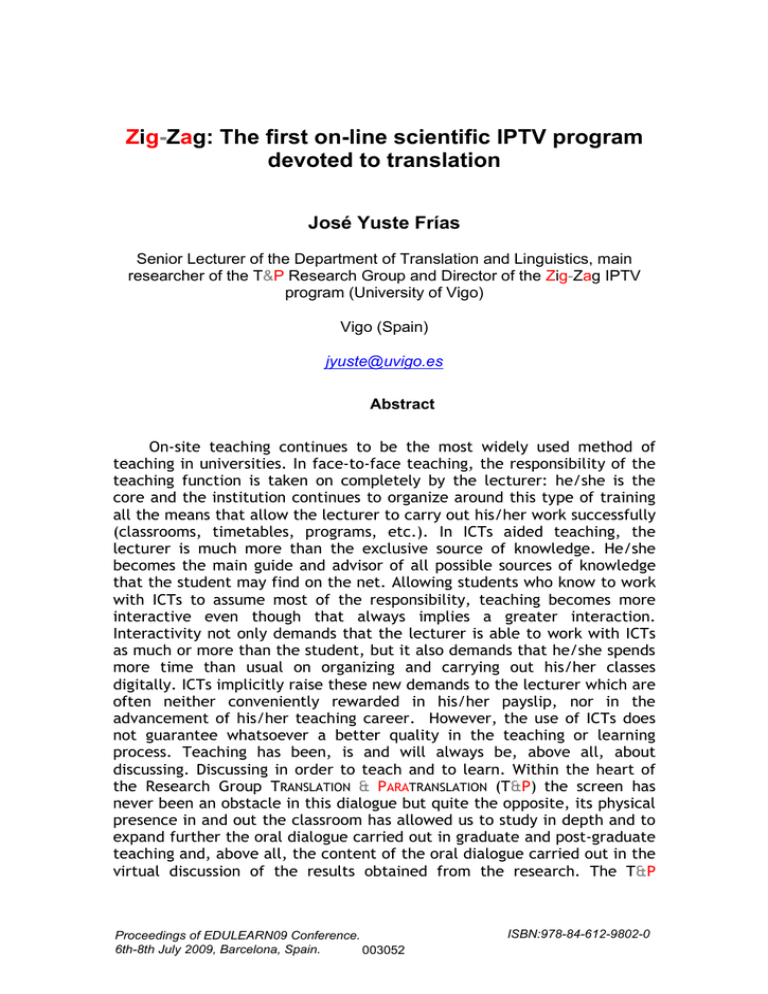
Zig-Zag: The first on-line scientific IPTV program devoted to translation José Yuste Frías Senior Lecturer of the Department of Translation and Linguistics, main researcher of the T&P Research Group and Director of the Zig-Zag IPTV program (University of Vigo) Vigo (Spain) jyuste@uvigo.es Abstract On-site teaching continues to be the most widely used method of teaching in universities. In face-to-face teaching, the responsibility of the teaching function is taken on completely by the lecturer: he/she is the core and the institution continues to organize around this type of training all the means that allow the lecturer to carry out his/her work successfully (classrooms, timetables, programs, etc.). In ICTs aided teaching, the lecturer is much more than the exclusive source of knowledge. He/she becomes the main guide and advisor of all possible sources of knowledge that the student may find on the net. Allowing students who know to work with ICTs to assume most of the responsibility, teaching becomes more interactive even though that always implies a greater interaction. Interactivity not only demands that the lecturer is able to work with ICTs as much or more than the student, but it also demands that he/she spends more time than usual on organizing and carrying out his/her classes digitally. ICTs implicitly raise these new demands to the lecturer which are often neither conveniently rewarded in his/her payslip, nor in the advancement of his/her teaching career. However, the use of ICTs does not guarantee whatsoever a better quality in the teaching or learning process. Teaching has been, is and will always be, above all, about discussing. Discussing in order to teach and to learn. Within the heart of the Research Group TRANSLATION & PARATRANSLATION (T&P) the screen has never been an obstacle in this dialogue but quite the opposite, its physical presence in and out the classroom has allowed us to study in depth and to expand further the oral dialogue carried out in graduate and post-graduate teaching and, above all, the content of the oral dialogue carried out in the virtual discussion of the results obtained from the research. The T&P Proceedings of EDULEARN09 Conference. 6th-8th July 2009, Barcelona, Spain. 003052 ISBN:978-84-612-9802-0 Research Group has always used the vast training and research possibilities of ICTs. During the academic year 2004/05 we were the first to set up an on-line International PhD Program within the University of Vigo, a PhD course that has the same name as our research group, TRANSLATION & PARATRANSLATION PHD (D_T&P), and that during this academic year 2008/09 has gained a “quality award” from the Ministry of Science and Innovation. We were also the first to use the services of Uvigo-TV in order to record the conferences and seminars that we have been organising and coordinating since academic year 2004/05, resulting in a series of on-line publications that increase with each academic year. It was only natural that we should also be pioneers when it came to creating an innovative and somewhat transgressing digital format with the possibility of publishing the results of the research carried out by the T&P Group, but also with the possibility of carrying out an essential complementary activity for the training of our graduate and postgraduate students. Very early on I had the idea of creating an original space for the screen where, in the shortest time possible, we could give the best of ourselves as lecturers and researchers. This is how Zig-Zag was born, the first on-line scientific IPTV program devoted to translation Keywords –Technology in Education, E-learning Projects and Experiences in Translation Studies 1. TEACHING USING ICTS: ZIGZAG BETWEEN THE CLASSROOM AND THE SCREEN. On-site teaching continues to be the most widely used method of teaching in universities. In face-to-face teaching, the responsibility of the teaching function is taken on completely by the lecturer: he/she is the core and the institution continues to organize around this type of training all the means that allow the lecturer to carry out his/her work successfully (classrooms, timetables, programs, etc.). Academic freedom and organization of the class continue to be the essential values of this type of ‘traditional’ teaching in which the lecturer is the only figure responsible of the content. According to this canonical model, the professor conceives and transmits knowledge (he/she is the expert on the verbally transmitted content), he/she helps in the learning process (he/she observes, accompanies and manages the educational time and space with his/her classes and tutoring), he/she corrects and assesses (in fact, he/she legitimizes the institution by representing it) In ICTs aided teaching, the lecturer is much more than the exclusive source of knowledge. He/she becomes the main guide and advisor of all 003053 possible sources of knowledge that the student may find on the net. Allowing students who know to work with ICTs to assume most of the responsibility, teaching becomes more interactive even though that always implies a greater interaction1. Interactivity not only demands that the lecturer is able to work with ICTs as much or more than the student, but it also demands that he/she spends more time than usual on organizing and carrying out his/her classes digitally. ICTs implicitly raise these new demands to the lecturer which are often neither conveniently rewarded in his/her payslip, nor in the advancement of his/her teaching career. According to this new model in which everything or most of the teaching-learning process unavoidably goes through a machine (a computer) and where both the lecturer and the student are in permanent self-training, there prevails a generalized situation of autonomy ready for a permanent adaptation to changes. Even though there are many universities that currently promote the use of ICTs in order to put into practice off-site teaching process method, there is a generalized reluctance to pedagogical and educational change. The change of paradigm is slow. Those lecturers who are reluctant to accept the new paradigm select all those pieces of information that may square with the old paradigm and ignore the rest. This phenomenon hinders the mentioned lecturers from thinking of original solutions against the new challenges of teaching. However, adapting, using, promoting and becoming a defender of ICTs, allows one to open up to a more modern education. Although it is quite clear that the task may be easier if the university itself foresees a permanent training of its teaching staff by promoting creativity and facilitating the promotion of its more innovative lecturers. However, the use of ICTs does not guarantee whatsoever a better quality in the teaching or learning process. Teaching has been, is and will always be, above all, about discussing. Discussing in order to teach and to learn. In order to teach his/her student, the lecturer always creates and specific learning rhythm that varies according to the personalities present and to the face-to-face space-time circumstances within all act of transmission and acquisition of knowledge, which is what a class has always 1 Even though the concept of ‘interactivity’ is a relatively new concept and it has a technical origin, the concept of ‘interaction’ is an old one and it has nothing technical about it. Teaching has always implied interaction whether it has used IT or not. In fact, if there is no lecturer-student interaction there can never be any teaching, let alone any learning. Interaction does not imply the compulsory use of interactive machines and, vice-versa, interactive machines do not automatically imply the existence of interaction. 003054 been. Within the heart of the Research Group TRANSLATION & PARATRANSLATION (T&P)2 the screen has never been an obstacle in this dialogue but quite the opposite, its physical presence in and out the classroom has allowed us to study in depth and to expand further the oral dialogue carried out in graduate and post-graduate teaching and, above all, the content of the oral dialogue carried out in the virtual discussion of the results obtained from the research. The T&P Research Group has always used the vast training and research possibilities of ICTs. During the academic year 2004/05 we were the first to set up an on-line International PhD Program within the University of Vigo, a PhD course that has the same name as our research group, TRANSLATION & PARATRANSLATION PHD (D_T&P), and that during this academic year 2008/09 has gained a “quality award” from the Ministry of Science and Innovation. We were also the first to use the services of Uvigo-TV in order to record the conferences and seminars that we have been organising and coordinating since academic year 2004/05, resulting in a series of on-line publications that increase with each academic year. It was only natural that we should also be pioneers when it came to creating an innovative and somewhat transgressing digital format with the possibility of publishing the results of the research carried out by the T&P Group, but also with the possibility of carrying out an essential complementary activity for the training of our graduate and postgraduate students. Very early on I had the idea of creating an original space for the screen where, in the shortest time possible, we could give the best of ourselves as lecturers and researchers. This is how Zig-Zag was born, the first on-line scientific IPTV program devoted to translation. 2 http://webs.uvigo.es/paratraduccion/index.html 003055 Screenshot of the first of the 7 Flash sequences that belong to the presentation of Zig-Zag published in José Yuste Frías’ website. 2. Zig-Zag: an on-line television for interpreting and translating We are living a multimedia age thanks to digital technology, an age where translation forms part of a set of functions which are not translation functions proper, but they are intimately related to the different linguistic and non linguistic communication practices. Verbal language is beginning to play a less important role in the production of sense compared to the image. Within the professional translation market we are witnessing on a daily basis a renewed interest in image. The use of a visual rhetoric packed with symbols and images to communicate sense independently from the traditional systems of writing is a global phenomenon and the result of the digital revolution. The translation jobs of today’s digital market place the translator everyday in front of the screen rather than in front of a piece of paper. And we all know that on screen images run rings around words. In sum, image is conquering a privileged position within written digital communication. 003056 In the middle of an era of on-line TV, the University cannot continue to ignore the everyday reality of the new languages that are present in this type of digital communication in the training and research environment. Given that television represents the medium through which most young people build their cognitive perception and organisation of the outside reality, on-line television can and should become a “cognitive monitor” for university training and research. Within the University, television stops being an idiot box and becomes a “social object” of great importance when it comes to spreading the knowledge, as it represents the medium through which all viewer builds two types of relation with knowledge: on the one hand, a sense relation between the viewer and the process of learning (i.e. the act of learning) and, on the other hand, a sense relation between the viewer and the product of learning (i.e. knowledge as an acquired competence and as a cultural, institutional and social object). Immersed in a policy of real knowledge transference, one of the main projects of the TRANSLATION & PARATRANSLATION (T&P) Research Group was that the production of Zig-Zag reached a satisfactory conclusion. Thanks to the financial aid of the RESEARCH VICERECTORY and the logistical support of the NEW TECHNOLOGIES AND QUALITY VICERECTORY of the UNIVERSITY OF VIGO, Zig-Zag aims to be a new on-line scientific IPTV program in order to reflect on translation and to show the on-line public the results obtained from the research carried out in the field practices of the T&P Research Group. From Vigo, a cosmopolitan harbour-town, we aim to open new theoretical, educational and professional horizons on Translation Studies. • We have created Zig-Zag to launch new critical, curious and fun glances at the how, the when, the where, the why, what for and for whom we translate nowadays. • In Zig-Zag we decipher in a playful and somewhat impertinent manner the policies and cultural ways of translating that arise when different societies come into intercultural contact. • Zig-Zag is the first on-line IPTV program devoted to the world of translation because Zig-Zag is a desire to understand in order to be able to interpret and translate. 003057 Screenshot belonging to the text presentation of Zig-Zag published in José Yuste Frías’ website. Taking a project of the importance of Zig-Zag in the right direction entails hard work, something which not all lecturers are willing to undertake. After a long run of tests and image and sound checks, and having the expert and professional and always invaluable help of the excellent staff of Uvigo-TV (Luis Pena Morandeira and Vicente Goyanes de Miguel); after long hours of rehearsals and more rehearsals in front of the cameras in order to act in a way that could communicate all the previous efforts writing the script in the most natural way possible. After many photo and video safaris carried out in the last years by Anxo Fernández Ocampo, Martiño Prada Díaz, Saleta Fernández and José Yuste Frías through the urban and rural spaces of various villages and towns of Spain, Portugal, USA, Uganda, Switzerland, Italy and France with the aim of gathering together at first hand the best possible material that could be the object of study of the program… At last we began to record in the studio the first pilot program in 2007. Thanks to the always active and 003058 tireless collaboration of Martiño Prada Díaz and Luis Pena Morandeira in the editing and post-production, respectively, in June 2008 we finished the on­ line publication of the first two episodes of Zig-Zag. The full acknowledgements of each episode go as follows: • First episode: Papamoles & Filitesos (AUTHOR: Anxo Fernández Ocampo) Direction: José Yuste Frías Assistant to the director: Vicente Goyanes de Miguel Production: Luis Pena Morandeira Production assistant: Martiño Prada Díaz First camera (studio): Luis Pena Morandeira First camera assistant (studio): David Souto Caramés Editing: Martiño Prada Díaz Post-production: Luis Pena Morandeira Executive production: T&P_UVigo-TV < http://www.uvigo.tv/gl/video/2454 > Screenshot of the acknowledgements section of the first episode of Zig-Zag published in José Yuste Frías’ website. 003059 • Second episode: Para-translating Carrefour (Part One) (AUTHOR: José Yuste Frías) Direction: José Yuste Frías Assistant to the director: Vicente Goyanes de Miguel Production: Luis Pena Morandeira Production assistant: Martiño Prada Díaz First camera (studio): Luis Pena Morandeira First camera assistant (studio): David Souto Caramés Second camera (exteriors): Martiño Prada Díaz and José Yuste Frías Editing: Martiño Prada Díaz Post-production: Luis Pena Morandeira Executive production: T&P_UVigo-TV < http://www.uvigo.tv/gl/video/2455 > Screenshot of the acknowledgements section of the second episode of Zig-Zag published in José Yuste Frías’ website. 003060 3. Interaction and interactivity in Zig-Zag From the moment the idea of the Zig-Zag television program was born, an interactive approach was set in the heart of the T&P Group when it came to create, make and edit the different episodes of the program. We established a much more innovating construction of university training and research experiences compared to the more traditional ones: at once there emerged what we could call “field studies in human and social sciences”. With their emergence began the creation of a complex process of training and research with a lot of feedback, which allows the existence of an important movement of knowledge which covers from a progressive accumulation of scientific knowledge obtained through basic research to the postgraduate students enrolled in the T&P PhD Program and also the graduate students enrolled in the Translation and Interpretation degree, with a very special participation of all the students enrolled in the subject Orthotypography for Translators. These “study outings” entail a teaching experience “outside the classroom” with the hope of awakening a reflection on translation in three dimensions with the help of the everyday objects of communication present in the urban space. The experience accumulated from the “study outings” during these last years has resulted in the creation of a new PhD course within the T&P PhD Program: Glances at the urban environment: para-translating the city. In this course we consider urban environments as communication experiences and, as a consequence, as real translation and interpretation environments even though they may appear unilingual. In these field practices we aim to awaken the students, more than the simple observation of urban environments, to a new way of reading, interpreting and translating the urban environment between different languages (interlinguistic translation), between different semiotic codes (intersemiotic translation) and between different cultures (intercultural translation) in the omnipresent advertising communication of our cities. Each time we carry out our “field practices” the institutional visibility of the University of Vigo becomes more than obvious, especially outside Spain, when the residents of the visited city are surprised to see our bus with the logos of the University of Vigo and the T&P Research Group. 003061 Bus hired in 2008 for the study outing to Fafe (Portugal) © Photo by José Yuste Frías In our “study outings” we always establish a crossed dialogue with all the aforementioned students and who present in situ. This dialogue allows teaching in praesentia on the part of the teacher, and once it is published on­ line as a Zig-Zag episode, becomes learning in absentia on the part of the of the student thanks to the ICTs. As an example of which I consider a good didactic field practice I will mention the last study outing of the academic year 2007-2008, that took place in June of 2008 in the town of Fafe (Portugal) under the subject of Glances at the urban environment: translation, emigration and transference of architectural styles, in which the PhD students Ms. Helena Costa Alves Guimaraes and Ms. Luisa Langford Correia Dos Santos participated very actively, as they were in charge of the preparation and organization of all the route across the urban environment. 003062 Group of people who attended the study outing to Fafe (Portugal) in 2008 © Photo by Anxo Fernández Ocampo An intensive day of live recording, full of creativity in each one of the continuous interventions made throughout the way, is giving, thanks to the work of editing carried out by Martiño Prada Diaz, with the active collaboration of the authors of each intervention, as a result more than a dozen episodes of ten to fifteen minutes long each one. I would like to emphasize here the titanic work that entails for a PhD student like Martiño Prada Diaz, the only person taken on by the T&P Group so far, to undertake the editing and post-editing of everything recorded with Uvigo-TV (including labial synchronization of the sound when this has been lost in the recording microphone that goes with the camera): these are hours, weeks and months of work that are always rewarded with the satisfaction of a well done job, but which should have greater value when counting towards both the scientific production and the training in research of someone who is beginning his research career. Even though it is quite clear that the experience acquired by the aforesaid PhD student at the time of working, first behind the cameras and later in front of the screens of the editing computer equipment, is turning out to be one of the most enriching aspects of his research training, especially if we consider the fact that the title of the PhD thesis he is working on is Locatization of multimedia products: videogames translation & paratranslation. With this kind of training and research that offers the possibility of collaborating in Zig-Zag, we have been able to reach ideal 003063 levels of interaction and interactivity between PhD student and thesis director. While we write the script of each episode, we select photos, images and illustrations that will go along with the audio on the screen; we prepare, manage, organize and coordinate the different outdoor and study recordings, and when, finally, the whole finished product is published on-line, the time invested can be from 3 to 6 months. Only with the construction of a compact team, made by people with different interests and points of view, will we be able to publish monthly an original audiovisual production, which is what I aspire to. That is why one of my main goals is that the PhD students enrolled in the PhD program of T&P, the research scholarship holders and the senior researchers of the T&P Group actively participate in all and each one of the different phases and processes that the edition of each Zig-Zag episode entails. This is, ultimately, about putting into action a set of interactions between the teaching staff, on one hand, and the research staff in training, on the other hand, so that experience and knowledge are mutually reinforced in a permanent interaction and interactivity. 4. Zig-Zag: innovates and makes impact The way in which the innovation of Zig-Zag was conceived and took place has to do with the combination of very different and at the same time complementary elements such as: cross-disciplines in the process, creativity at work, the design of the program’s logo (original creation of Luis Pena Morandeira), the quality of the finished product, etc. Regarding the spreading of the results, Zig-Zag has meant the incorporation of new audiovisual products and services for the benefit of both the scientific community and the public in general. Zig-Zag is a scientific process of understanding reality which is carried out thanks to the professors and researchers’ intellectual resources, and with the help of important material resources. Zig-Zag is also a finished product which, once established the desired production rate, can generate wealth and employment in various sectors of the audiovisual industry and the advertising market. The impact rate of Zig-Zag can be perfectly measured by the number of visits the program has had up to now since it was published on-line on the th 10 of June, 2008: more than 1,500 visits during the months that followed the June maelstrom, amount that, added to the 476 visits registered since the beginning of the academic year to the current date (01/31/2009), gives us a total of approximately 2,000 visits. 003064 Screenshot of the presentation of the Zig-Zag program published on the Uvigo-TV website On the other hand, I consider that good impact ratings for a research project of any University lies also in spreading and advertising itself in the best possible way within the live forces of its city. I am referring to the publishing of a full page article, published on paper and online on 11/8/2008, in the most representative newspaper of the city of Vigo and dean of the Spanish press: Faro de Vigo. It is an interview that the aforesaid newspaper made to whom pens this publication and in which we insist on the innovation in the university training and research that the work that we are carrying out at the T&P research group from the University of Vigo entails. There is no better way of finishing this publication and writing its last line than by reproducing word for word the aforementioned press article’s headline: Vigo revolutionizes translation and spreads its studies in a television program. 003065 PENELAS, S.: “Vigo revolutionizes translation and spreads its studies in a television program”, published in Faro de Vigo on 8/11/2008 003066
